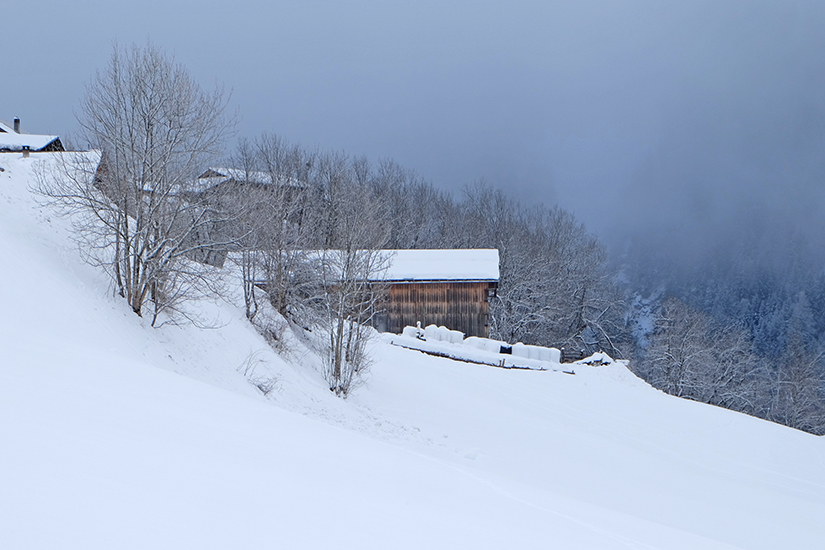 |
 |
 |
 |


Arno Deplzaes Stable
Buortga 2, Duvin
1997
Since the beginning of his work in the village of Vrin, Gion A. Caminada
has been intensively involved in the construction of stables and barns.
In most cases, these are architectural works for small farms, which
require a holistic view. The basis for this work is the analysis from
the year 1990, which Gion A. Caminada had worked out together with the
department for preservation of monuments. For his numerous barns and
stables in Vrin, the architect has developed his own construction
system. Due to the economic aspects, Gion A. Caminada has repeatedly
chosen constructions in which the client can provide as much personal
contribution as possible. For the construction of his stables and
barns, the architect refers to the many anonymous builders, and
developed design models based on the traditional construction methods.
Most of his stables have a level for the animals and an overlying
threshing floor. In terms of construction, Gion A. Caminada relies on
the traditional method of layering roundwoods. In these historic
commercial buildings, the logs were clad with boards on the outside, so
that the joints remain visible only at the corners. Related to these
constructions, horizontal wooden frames are stacked on top of one
another and planked on the outside with vertical boards, whereby the
connection of the static frames remains visible. The wooden frames have
a height of 1.25 meters, with different lengths of up to a maximum of
12 meters. In this relatively inexpensive construction, the wooden
frame can be prefabricated and transported as elements to the site. Due
to the contemporary hay processing relatively large, air-permeable
chambers are required in order not to affect the performance of the hay
blower. For this reason, most of the new stables are relatively large
in comparison with the historical models. The facades are individually
adapted to the requirements and needs of each situation, and provided
with windows and doors accordingly. The buildings are concluded by a
single-pitch or gable roof. The Arno Deplazes Stal in Duvin was created
on the basis of the previously described construction system.
Seit dem Beginn seiner Arbeit in der Gemeinde Vrin hat sich Gion A. Caminada intensiv mit der Bauaufgabe Stall und Scheune beschäftigt. In den meisten Fällen handelt es sich dabei um architektonische Arbeiten für kleine Landwirtschaftsbetriebe, welche eine gesamtheitliche Betrachtung erfordern. Basis für diese Arbeiten bildet die Analyse aus dem Jahr 1990, welche Gion A. Caminada zusammen mit der Denkmalpflege erarbeitet hatte. Für seine zahlreichen Scheunen und Ställe in Vrin hat der Architekt ein Konstruktionssystem entwickelt. Aufgrund der wirtschaftlichen Aspekte hat Gion A. Caminada dabei immer wieder Konstruktionen gewählt, bei denen der Auftraggeber möglichst viel Eigenleistung erbringen kann. Für den Bau seiner Ställe und Scheunen beruft sich der Architekt auf die vielen anonymen Baumeister, und entwickelte Konstruktionsmodelle in Anlehnung an die traditionellen Bauweisen. Die meisten seiner Ställe weisen eine Ebene für die Tiere und eine darüber liegende Tenne auf. Bei der Konstruktionsweise beruft sich Gion A. Caminada auf die traditionelle Methode des Schichtens von Rundhölzern. Bei diesen historischen Wirtschaftsbauten wurden die Rundhölzer aussen mit Brettern verkleidet, so dass die Verbindungsstellen lediglich an den Ecken sichtbar bleiben. In Anlehnung an diese Bauten werden im Konstruktionssystem Caminada horizontale Holzrahmen übereinander geschichtet und aussen mit vertikalen Brettern beplankt, wobei die Verbindung der statischen Rahmen ebenfalls sichtbar bleibt. Die Holzrahmen weisen eine Höhe von 1.25 Meter auf, bei unterschiedlichen Längen von bis zu maximal 12 Meter. Bei dieser verhältnismässig kostengünstigen Bauweise können die Holzrahmen vorgefertigt und als Elemente zur Baustelle transportiert werden. Aufgrund der zeitgenössischen Heuverarbeitung sind relativ grosse, luftdurchlässige Kammern erforderlich, um die Leistung der Heugebläse nicht zu beeinträchtigen. Aus diesem Grund sind die meisten der neuen Stallbauten im Vergleich mit den historischen Vorbildern verhältnismässig gross. Die Fassaden werden individuell auf die Anforderungen und Bedürfnisse der jeweiligen Situation angepasst, und entsprechend mit Fenstern und Türen versehen. Die Bauten werden jeweils durch ein Pult- oder Giebeldach abgeschlossen. Der Arno Deplazes Stal in Duvin ist auf Grundlage des zuvor beschriebenen Konstruktionsystems entstanden.
Seit dem Beginn seiner Arbeit in der Gemeinde Vrin hat sich Gion A. Caminada intensiv mit der Bauaufgabe Stall und Scheune beschäftigt. In den meisten Fällen handelt es sich dabei um architektonische Arbeiten für kleine Landwirtschaftsbetriebe, welche eine gesamtheitliche Betrachtung erfordern. Basis für diese Arbeiten bildet die Analyse aus dem Jahr 1990, welche Gion A. Caminada zusammen mit der Denkmalpflege erarbeitet hatte. Für seine zahlreichen Scheunen und Ställe in Vrin hat der Architekt ein Konstruktionssystem entwickelt. Aufgrund der wirtschaftlichen Aspekte hat Gion A. Caminada dabei immer wieder Konstruktionen gewählt, bei denen der Auftraggeber möglichst viel Eigenleistung erbringen kann. Für den Bau seiner Ställe und Scheunen beruft sich der Architekt auf die vielen anonymen Baumeister, und entwickelte Konstruktionsmodelle in Anlehnung an die traditionellen Bauweisen. Die meisten seiner Ställe weisen eine Ebene für die Tiere und eine darüber liegende Tenne auf. Bei der Konstruktionsweise beruft sich Gion A. Caminada auf die traditionelle Methode des Schichtens von Rundhölzern. Bei diesen historischen Wirtschaftsbauten wurden die Rundhölzer aussen mit Brettern verkleidet, so dass die Verbindungsstellen lediglich an den Ecken sichtbar bleiben. In Anlehnung an diese Bauten werden im Konstruktionssystem Caminada horizontale Holzrahmen übereinander geschichtet und aussen mit vertikalen Brettern beplankt, wobei die Verbindung der statischen Rahmen ebenfalls sichtbar bleibt. Die Holzrahmen weisen eine Höhe von 1.25 Meter auf, bei unterschiedlichen Längen von bis zu maximal 12 Meter. Bei dieser verhältnismässig kostengünstigen Bauweise können die Holzrahmen vorgefertigt und als Elemente zur Baustelle transportiert werden. Aufgrund der zeitgenössischen Heuverarbeitung sind relativ grosse, luftdurchlässige Kammern erforderlich, um die Leistung der Heugebläse nicht zu beeinträchtigen. Aus diesem Grund sind die meisten der neuen Stallbauten im Vergleich mit den historischen Vorbildern verhältnismässig gross. Die Fassaden werden individuell auf die Anforderungen und Bedürfnisse der jeweiligen Situation angepasst, und entsprechend mit Fenstern und Türen versehen. Die Bauten werden jeweils durch ein Pult- oder Giebeldach abgeschlossen. Der Arno Deplazes Stal in Duvin ist auf Grundlage des zuvor beschriebenen Konstruktionsystems entstanden.